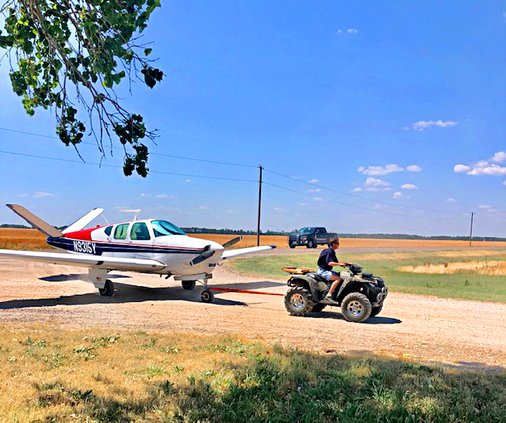by Larry D. Fenwick
Special to the Tribune
If you are like most people, since March of this year when you look up into the sky something is missing. Commercial airliners are not flying! At a recent town hall meeting the current FAA Administrator, Mr. Steve Dickson, noted that “at most airports, traffic is down 92% and you will see more Cessna 172s on flight tracking than Boeing 737s.”
On the morning of Tuesday, June 16, at about 8:30 a.m., pilot David Rolph took off from Jabara Airport (KAAO) in Wichita. He was not flying a Cessna 172, although that was the plane he first flew when he was in his early days of flying. This morning he was flying another legendary single engine general aviation airplane, a Beech Bonanza. David was part owner of this iconic V-Tail airplane. He was headed to the Colorado Springs airport (KCOS).
The Bonanza has been in continuous production since it was first introduced in 1947. Built in Wichita, more than 17,000 planes have been assembled at the Beech factory, now part of Textron Aviation. Last Tuesday morning there was a moderate tailwind from the southeast and David’s estimated flight time to KCOS was 2 hours and 23 minutes, flying at an altitude of 8,000 ft. The flight to KCOS took him over familiar terrain. He had flown the route many times before, but this time his flight turned dramatically different.
After being in the air for about 20 minutes, and after passing over Stafford and nearer to St. John, the plane began to shudder violently. His engine was running, the prop was still turning, but he quickly realized he had a major problem. David was on an instrument flight plan (IFR) and was in communication with Kansas City Center (Air Traffic Control ATC). His first thought was to check his fuel tanks, and he switched tanks to see if that would help. He then tried adjusting his throttle and prop settings. Nothing was helping smooth out his engine. It was running, but for how long?
The engine ran rough for about another two minutes until it completely seized up. At that point he was about midway between Pratt and Great Bend, and after a discussion with center he chose to set the plane up for “best glide speed” to Great Bend. Having had some sailplane experience, David quickly realized that Great Bend was too far away to “glide.” He knew he would never make the airport. A few miles west of St. John, he was about to make his first real, not in training “off airport dead engine landing.”
David surveyed the area beneath him and spotted two paved roads; however, the north-south road had several vehicles traveling in both directions, so his focus became the paved east-west road, 30th Street, which runs from St. John to the north-south Dillwyn Road. With no vehicles in sight, he had the altitude to set up a normal landing to the west. However, as he descended, he saw signs and posts along both sides of the paved road, and he made the quick decision to land just north of the road in a partially cut wheat field. Straw had been bailed into large round bales, and he carefully managed his remaining airspeed and altitude to avoid hitting any of the round bales, putting in his normal flap settings at the appropriate time and landing on the two main wheels, holding the nose wheel off the ground for as long as he could. He came to a quick stop in the dirt and stubble and exited the airplane.
David had been in communication with KC Center, who had alerted the proper authorities that he had made an emergency landing west of St. John. Soon police and local residents arrived to help David. The most important point was that he was safe, and except for the seized-up engine, his Bonanza was undamaged. David had made the “perfect dead engine off airport landing.”
The next day the plane was towed along various county roads by members of Crotts Avaition, from Dodge City, to a hangar in Macksville where further investigation and repair work will soon begin. David expressed his thanks to the controller in KC who so calmly helped him through his flight emergency. He also expressed his extreme gratitude for all of the caring individuals with the Stafford County Police Department, as well as other local citizens who offered help.
About the pilot
David Rolph and his older brother Darrel, who passed away in 2011, were one of the earliest franchisees of Pizza Hut restaurants. They sold their restaurants to Pepsi Cola in 1994 but continued in the restaurant business under the name Sasnak Management. Today David’s son Jon is heading up the company, which operates 63 restaurants in 10 states, including the Carlos O’Kelly name, many Applebee restaurants, and three newly opened HomeGrown restaurants located in Wichita.





